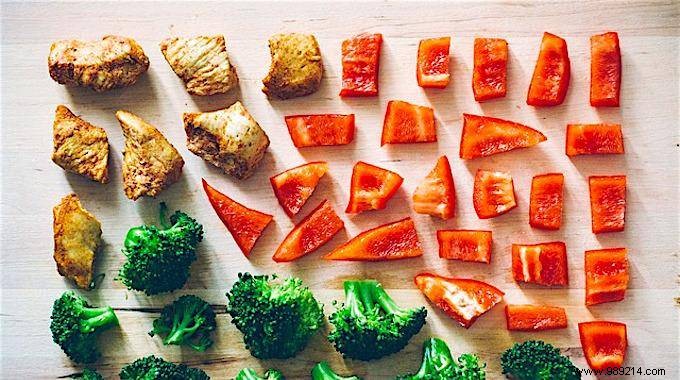
To have a healthy and balanced diet, it is essential to consume foods full of vitamins.
But what are the precise benefits of vitamins on our body? And which foods contain the most vitamins ?
Luckily, here's a handy chart for you to share, print, and use the next time you're cooking.
That way, when you're cooking a meal or shopping, you'll know exactly which foods contain which vitamins.

Click here to easily view and print this guide in PDF.
Contributes to vision and hydration of the skin. Facilitates the growth of bones and teeth. Strengthens the immune system and reproduction.
Foods rich in vitamin A:
• mangoes
• carrots
• butternut squash
• pumpkin
• broccoli
• beef liver
Increases basal metabolism and strengthens the functioning of the nervous system.
Foods rich in vitamin B1:
• watermelon
• tomatoes
• spinach
• soy milk
• defatted ham
• pork chops
• sunflower seeds
Increases basal metabolism. Contributes to healthy vision and skin.
Foods rich in vitamin B2:
• spinach
• broccoli
• mushrooms
• milk
• eggs
• liver
• Oysters
• clams
Increases basal metabolism. Contributes to good skin health. Contributes to the proper functioning of the nervous system and the digestive system.
Foods rich in vitamin B3:
• spinach
• potatoes
• tomatoes
• extra lean ground beef
• chicken breast
• shrimp
• canned tuna (natural)
• liver
Intervenes in the transformation of amino acids and fatty acids. Stimulates the production of red blood cells.
Foods rich in vitamin B6:
• bananas
• watermelon
• tomatoes
• potatoes
• broccoli
• spinach
• chicken breast
• white rice
Contributes to cell synthesis. Participates in the transformation of amino acids and fatty acids. Also involved in the functional integrity of nerve cells.
Foods rich in vitamin B12:
• milk
• meat
• poultry
• fish
• eggs
• seafood
Used in the synthesis of new cells. Contributes to the transformation of fatty acids and amino acids. Also involved in the functional integrity of nerve cells.
Foods rich in vitamin C:
• mangoes
• oranges
• lemons
• grapefruits
• strawberries
• kiwi fruit
• spinach
• broccoli
• Red peppers
• snap beans
• tomatoes
Vitamin D promotes bone mineralization.
Foods rich in vitamin D:
• fortified milk
• Egg yolk
• liver
• oily fish
• sun exposure
Has antioxidant properties. Reduces the harmfulness of free radicals and participates in the stabilization of the cell membrane.
Foods rich in vitamin E:
• vegetable oils rich in polyunsaturated fatty acids
• lawyers
• cod
• shrimp
• tofu
• wheat
• sunflower seeds
Contributes to the synthesis of proteins necessary for blood coagulation. Regulates blood calcium levels.
Foods rich in vitamin K:
• spinach
• broccoli
• Brussels sprouts
• green leafy vegetables
• liver
Contributes to DNA synthesis and cell synthesis.
Foods rich in vitamin B9:
• tomatoes
• broccoli
• spinach
• asparagus
• okra
• green beans
• currant beans
Increases basal metabolism. Promotes the transformation of fat and amino acids. Facilitates the synthesis of glycogen.
Prevalent in all foods
Increases basal metabolism.
Prevalent in all foods
There you go, now you all know the benefits of vitamins on your health as well as the foods that contain the most :-)
Share this guide with your loved ones and print it to consult it whenever you want!
And don't forget:contrary to popular belief, cooking food does not destroy its vitamin content!